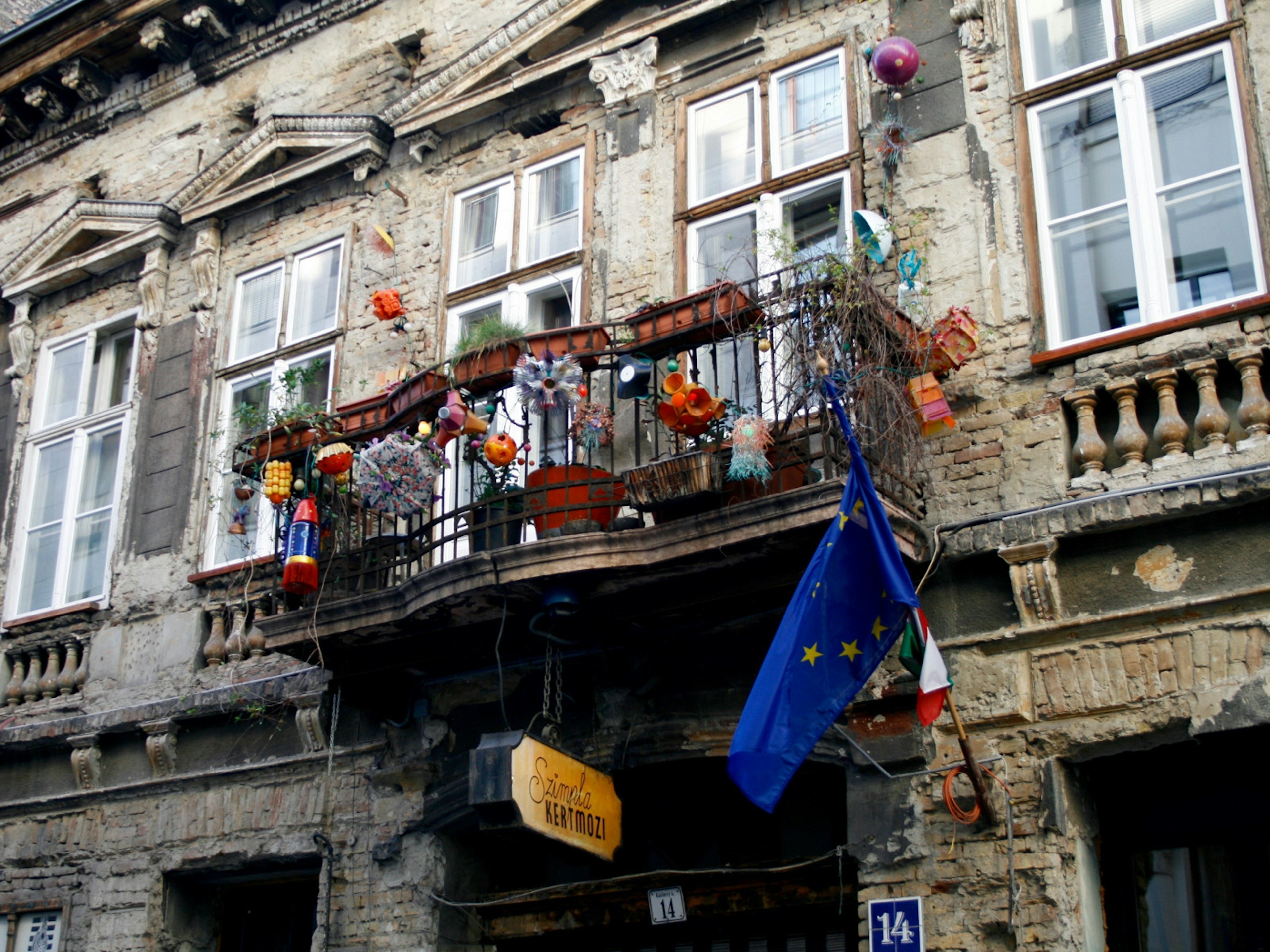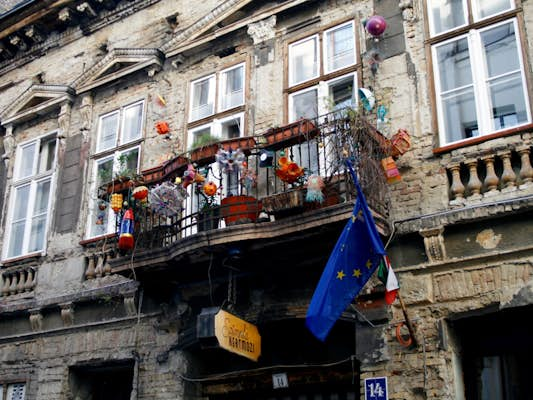Budapest’s seventh district, also known as the Jewish Quarter, once home to a flourishing Jewish community which languished for decades after World War II, has emerged as one of the best bar-hopping ’hoods on the busy Pest side of the Danube.
This renaissance has been led – fittingly, perhaps, given the still-derelict state of much of the area – by a string of so-called ‘ruin bars’ (romkocsma in Hungarian) that have opened in recent years along the back streets behind the Great Synagogue.
Today these establishments are among the nightlife staples of the Hungarian capital, offering a unique mix of drinking, dancing and socializing in a slightly shabby but always charming setting. Here’s the guide to the best ruin bars in Budapest.

What is a ruin bar?
Each ruin bar is unique, but they all share certain similarities. The main ingredient is usually an abandoned building (hence the ‘ruin’ part in the name), preferably with a vacant lot nearby to hold some picnic tables and a few beer taps. Add to that a bit of thrift-shop decor and a healthy dose of hipster vibe and the result is what you might get if you crossed a chill Berlin squat with a smallish Munich beer hall.
The best ruin bars in Budapest offer live music or DJs on the weekends, as well as film nights and art exhibitions. Some have light food and hostel accommodation, or even host farmers’ markets or creative events during the day. They’re the perfect spot to unwind on a warm summer night after a busy day of sightseeing.

History of ruin bars in Budapest
The arrival of the ruin bars couldn’t have come sooner for beleaguered Budapest VII (as the city’s districts are designated; when in Budapest, do as the Romans do). Though the area is a stone’s throw from Andrássy út, Pest’s swankiest boulevard, it suffered from a mix of neglect, bad karma and poverty that started during the war with the deportation of tens of thousands of Jewish residents and continued into the 1960s, ’70s, and ’80s with the forced relocation here of the Roma to occupy the abandoned houses.
Now, main streets like Király utca and Dob utca are home to trendy coffeehouses and wine bars that sit alongside the remnants of Jewish life – small family-owned restaurants and bakeries – that managed to survive.

Tips on visiting the most popular ruin bars in Budapest
Budapest’s main ruin bars are all a short walk from one another and can be taken in fairly easily during a night of methodical drinking. They concentrate in the city’s Jewish Quarter (officially called District VII, seventh district, or Erzsébetváros). Each has its own personality, so the best bet is simply to find the one that best suits the night and the mood.
You can explore the bars on your own, but if you want a deeper historical and cultural immersion into the ruin bar lore, book a specialized walking tour. Most guided tours aren’t much different than your usual pub crawl experience with drinks (and sometimes food) included in the price. Although a pricier option (tours range from 25 to 100 USD depending on group size), they are a great way for solo travelers to meet.
And as Budapest is a year-round destination, there’s really no bad time to have fun at the city’s many ruin bars. Summer sees the pubs at their most cheerful with crowds taking over the inner courtyards. During winter, all the action goes indoors as bars throw thematic party nights, cinema sessions and art shows. Spring and autumn provide the most balanced ruin bar visit with both outdoor and indoor fun and fewer crowds.
What are the best ruin bars in Budapest?
Szimpla Kert
Nearly every discussion of ruin bars begins with the granddaddy of them all, Szimpla Kert (Hungarian for ‘Simple Garden’) on Kazinczy Street. Szimpla was the first to open and is still arguably the best and bawdiest of the bunch. Several rooms, including a large open-air garden with fairy lights, can accommodate hundreds of people, making it a good choice if you’re traveling in a group. In addition to beer, there’s wine, cocktails and light food. Also make sure you come on a Sunday morning, when it hosts a farmers’ market. And you can always buy souvenirs here, making Szimpla a Budapest shopping stop, too.
Instant-Fogas Complex
The Instant-Fogas Complex opened its doors in 2017 after merging two iconic Budapest venues: the Fogas Ház pub and Instant nightclub (once located on Nagymező utca in the VI District). Its mission goes beyond being just a ruin bar; it aims to be a comprehensive party complex. It’s split up into different parts: Fogas kert, an open-air ruin pub where the bar is covered by a circus tent; Liebling, a cozy cafe-bar serving food with an upstairs terrace in the summer; and Lärm, one of Budapest’s best techno clubs. It’s equipped with state-of-the-art gear in a black-box room and there’s an alternative rock club, Robot, in the basement of the garden.
Doboz
Head to Doboz on Klauzal utca, which combines an upscale cocktail bar atmosphere with the freedom-loving spirit of Budapest ruin bars. Two dance floors with weekend DJ sets, 3 bars, and a picturesque courtyard garden help get the party going. Just keep in mind that the prices here lean towards the higher end.
UdvarROM and Füge Udvar
These two ruin bars located on Klauzál utca are adjacent to one another and make a great pairing for a night out. Lower-priced UdvarROM has simple furniture, a garden area and a menu focused on vodka shots and draught beer. Füge Udvar is its flashier, more well-off neighbor. Apart from the bar, it has pool tables, air hockey, table tennis, foosball and arcade games.
Hidden gems
While many ruin bars cater to tourists, there are still some hidden gems that locals enjoy. Underground pub Lámpás (which is literally below the ground) comes with cozy ‘ruin’ aesthetics and live music every day. Affordable prices, vintage atmosphere, a packed agenda, and central location make it the ultimate ruin bar destination.
Another spot to mention is Csendes Létterem near Astoria metro station on the fringes of the Jewish Quarter. It’s the opposite of upscale, sporting time-worn tablecloths, sticker-filled walls and a throwback atmosphere. Yet, it’s among Budapest’s quirkiest, most authentic ruin bars.

Food-focused ruin bars
Kőleves (or the ‘Stone Soup’) represents a calmer version of a Budapest ruin bar. Offering a leafy beer garden-like courtyard, it serves an eclectic menu that mixes traditional (and delicious) Hungarian specialties like catfish stew served with noodles, with Jewish items like matzo ball soup and roast goose, and international fare like pasta and couscous. There are also lots of good vegetarian choices. Kőleves is ideal for pre-party drinks in the warmer months.
For more outdoor dining, head over to Karaván Street Food, a buzzy courtyard next door to Szimpla Kert. Here you’ll find a wide range of choices from sausages and fried cheese to lángos (a savory fried pastry topped with sour cream and cheese) and vegan burgers.
And if you want to dine at the next generation of ruin bars, book a table at Mazel Tov, a shabby-chic bar next to Fogas and Instant that serves excellent food with Middle Eastern flair. Its large fairy lights-illuminated inner courtyard is among the best in the Jewish Quarter. During the warmer months, this restaurant brings a Mediterranean vibe to the middle of Budapest. Mazel Tov works perfectly as a first stop on a fun-filled night.

